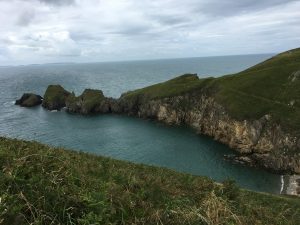We began our drive west to Wales on Saturday morning, with an intent to stop for lunch near Swansea, to spend an hour with a family friend who runs a pub there. When we arrived in Skewen, Anna had prepared a lovely spread for us — exactly what we all needed after the previous night of a bit too much wine. The little town near Neath was once an industrial village with several colliers nearby for copper and iron works. Those businesses have long since left, leaving not much more than a couple too many pubs and a local rugby team. It was important to see a part of England that had struggled to find a future much like the cities and towns of the U.S. industrial belt.
Then it was on to Pembrokshire and the small village of Solva. Situated on the south side of the St. David’s peninsula it is a perfect example of a flooded valley. The rocks at the entrance to the harbor made it a sheltered anchorage and Solva became the main trading centre of St Bride’s Bay in the medieval period, and was important for lime burning. Several lime kilns are preserved in the harbor area. In the 19th century, Solva had around 30 registered trading ships. The fading coastal trade has been replaced by tourism, and the harbor is now a popular boating centre. It also lies along the Pembrokeshire Coast National Park with several fine walking paths along the headlands.
We arrived when the tide was out, so we were able to walk along the river bed all the way out to the sea, so we joined many others and many dogs out to the shoreline. All the boats were standing in the mudflats, waiting for the tide to float again; it was a very long tidal range and apparently it rises over 8 feet when it does come in. We are staying at a lovely old B&B that’s been completely renovated and is just down the road from the house of some friends. Dinner of lobster straight out of the sea was a perfect end to the day.
Today Lucy and I took the coastal path to Newgate Beach, 5.5 miles away. The day was partially sunny (!) but windy and the views of the windswept coast and steep cliffs to the sea were just gorgeous. There were cows in some of the fields, and lots of ups and downs on the trail as we navigated the various headlands and hills. We passed stands of wheat and lots of deep purple heather. And when a rain squall came up while we were at the top of a hill, we had to hurry to put on raincoats as there was no where to hide from the almost horizontal sheets of water. And that ended as quickly as it had come up and we continued to the beach at the end with the wind at our backs.
We had a stop in a cafe and then walked down to the beach. I couldn’t resist taking a photo of the water and air temperature — most everyone in the water was wearing a wetsuit, but it was still pretty cold for a swim — 60 degrees F! The kite surfers were having a great time — the wind was perfect, and that was a pretty perfect day.
Tonight we will travel into St David’s further along the peninsula for dinner. I didn’t realize until I google-mapped it just now that there’s a ferry to Ireland from nearby! Clearly this is very Western Wales!















So sorry the weather is so dreary and wet for your Epic Adventure! I do hope the sun shines again very soon – I have just had to dash home from Church to avoid a soaking! Gill xxx
Despite the weather it was wonderful to see such lovely countryside in the Peak District, Hampshire and finally Pembrokeshire. I’ve just landed in France and so have another whole adventure ahead. I hope you’re doing well. Sending kind thoughts.
What are the stone structures?????
Old lime kilns
Beautiful scenery!